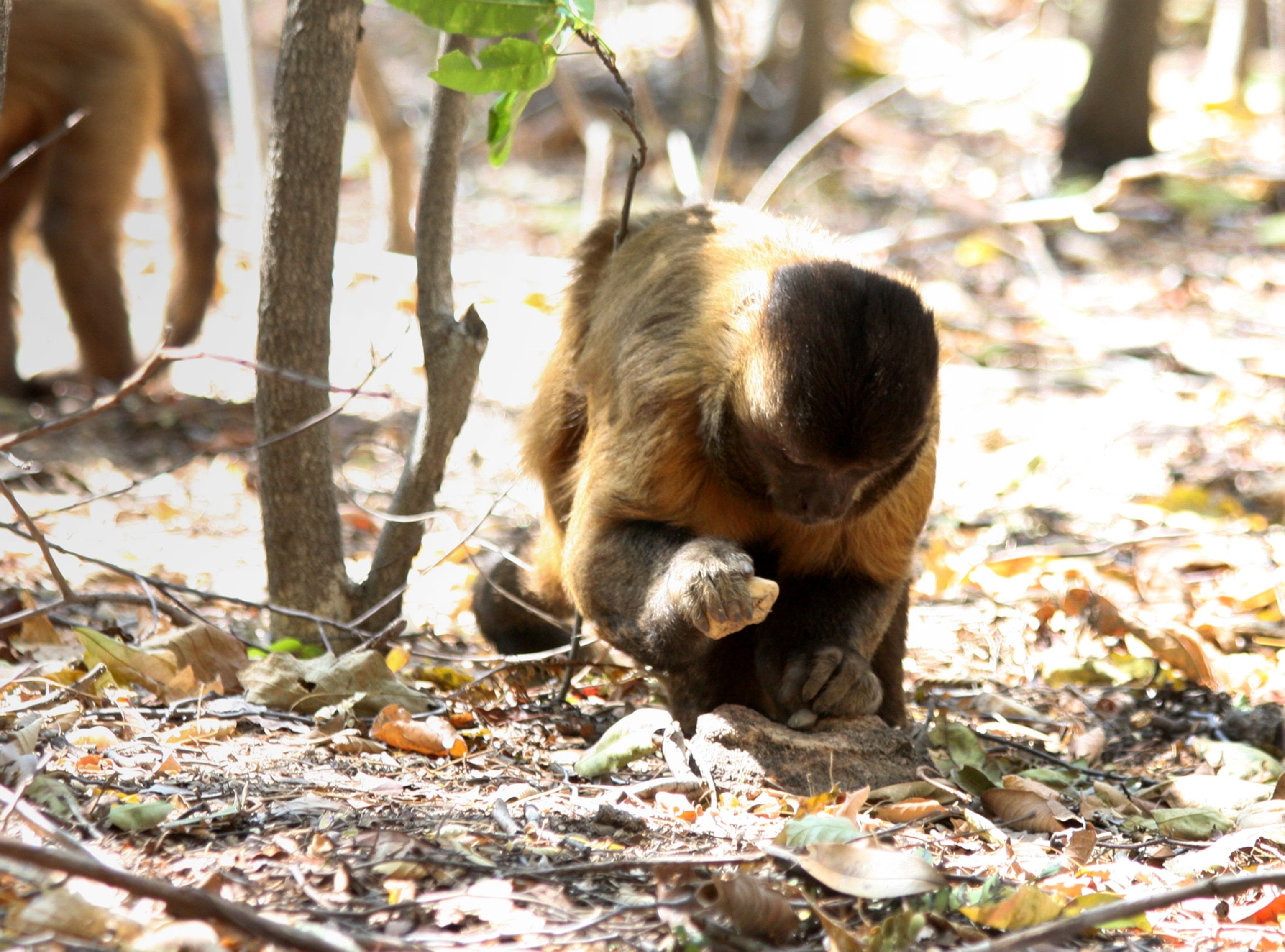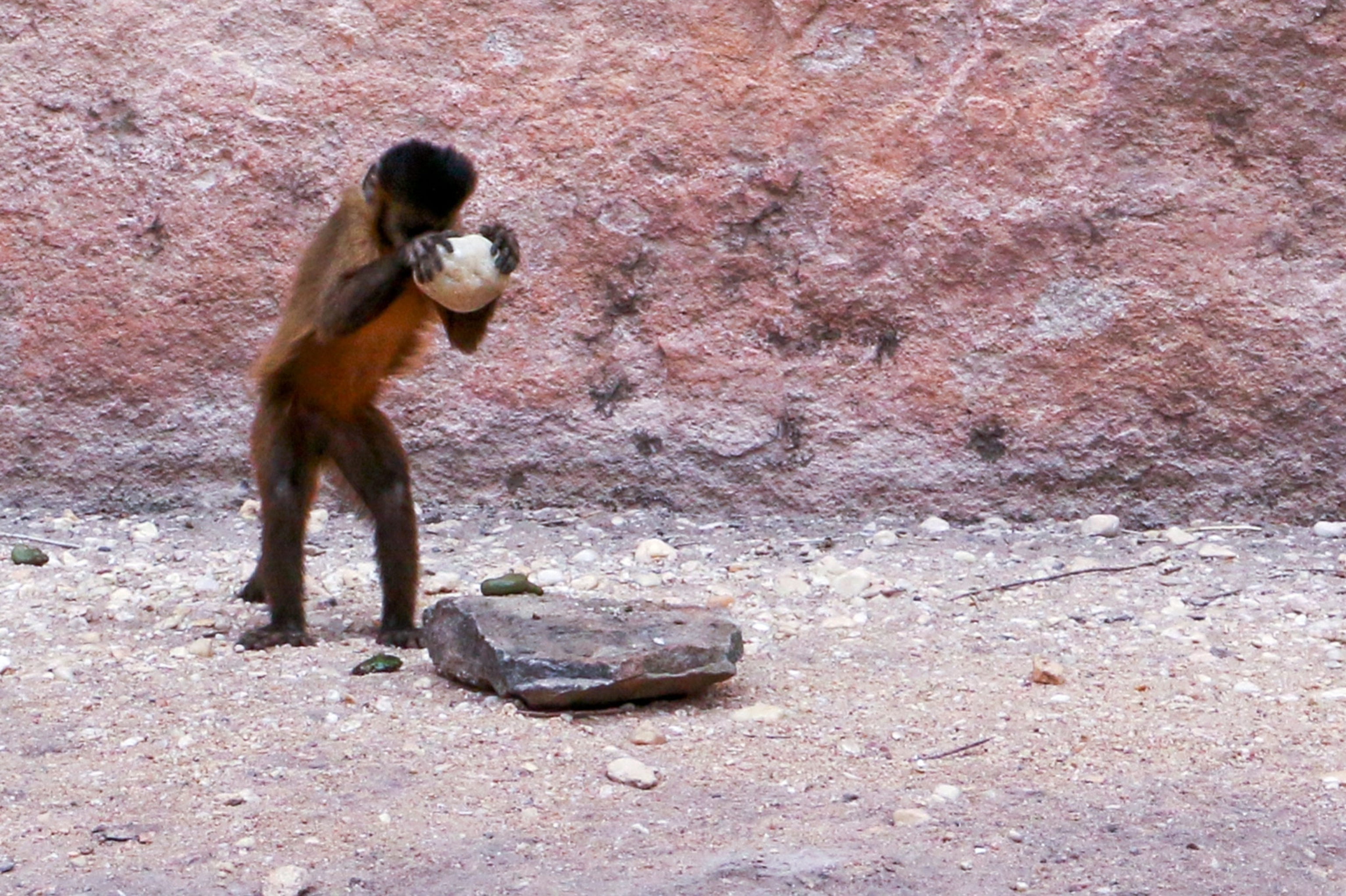
Oldest Non-Human Stone Tools Outside Africa Created by Monkeys
Archaeologists excavate cashew-crunching tool sets that have been used by capuchin monkeys in Brazil for a hundred generations.
An archaeological site in the Brazilian savanna has revealed the oldest record of non-human stone tool use found outside of Africa: centuries-old stone hammers and anvils wielded by hungry capuchin monkeys.
The rocks show that for at least 700 years, bearded capuchin monkeys (Sapajus libidinosus ) in Brazil’s Serra da Capivara National Park have smashed fresh cashews to peel off their caustic, unappetizing husks. The find confirms the behavior’s longtime importance to the area’s capuchins—which seem to have used the technique for a hundred generations—and adds vital nuance to the history of tool use in non-human primates.
“Archaeology has helped change our perspective on what humans are, by showing us the variety in our past, and hopefully the same may apply to non-human primates,” wrote study co-author Michael Haslam, head of the University of Oxford’s Primate Archaeology research group.
What Does It Take to Become a Stone Tool User?
The trove of tools, described on Monday in Current Biology, also stands to help scientists understand the bafflingly scattershot distribution of tool use among primates. Only a handful of non-human primate genera use hand tools—including chimpanzees, bearded capuchins, and long-tailed macaques—and scientists have yet to identify exactly why those species, and not others, took up tools.
“[To] understand the first emergence of technology, it’s useful to look at all stone-using primates, to find commonalities and figure out what it takes to become a stone tool user these days,” says co-author Lydia Luncz, a primatologist in the University of Oxford’s Primate Archaeology research group.
Archaeology has helped change our perspective on what humans are, by showing us the variety in our past, and hopefully the same may apply to non-human primates.Michael Haslam, University of Oxford's Primate Archaeology research group
It’s a massive task that scientists are just beginning to tackle. Serra da Capivara is only the second report of pre-modern, non-human stone tool use, outside of three chimpanzee sites in Côte d’Ivoire between 1,300 and 4,300 years old. In fact, scientists didn’t confirm that Brazilian bearded capuchins naturally used stone tools in the wild until 2004, despite centuries’ worth of folktales and anecdotal reports.
The new records confirm that not only is the behavior natural; it’s deeply rooted.
The Archaeology of Monkey Tools
When Haslam and his team of archaeologists and primatologists painstakingly dug up 377 square feet (35 square meters) of the savanna floor, they found 69 stone tools up to 2.7 feet (0.72 meters) below the surface.
The tools—worn-down hammers four times bigger than the average rock in the area, and pockmarked anvils four times bigger than the hammers—matched the form of modern capuchins’ tools. Chemical tests also revealed that the younger tools still bore cashew-husk residue, strongly indicative that they were once wielded by hungry capuchins.
What’s more, the team didn’t find any signs of indigenous or colonial human activity alongside the tools—a somewhat surprising absence, since Serra da Capivara is a World Heritage site and among the most important human archaeological sites in Brazil. Certainly, capuchins didn’t seem to pay Europeans any mind: some of the oldest capuchin tools dated back as far as 1266 A.D., more than 200 years before Columbus’s arrival in the Americas.

“Many people suggested that [tool use] was something [capuchins] learned, because animals were poached and released and had at least some human input,” says study co-author Eduardo Ottoni, a capuchin primatologist at Brazil’s University of São Paolo. “[Now] we can say for sure that at least they didn’t learn it from Europeans.”
Capuchin Culture?
Serra da Capivara isn’t the only site in Brazil with tool-wielding capuchins, and the differences between sites suggests that the populations’ tool-use quirks could amount to different capuchin cultures.
While Serra da Capivara capuchins pound the husks off of fresh cashews, for instance, capuchins at a second, more southerly site called Fazenda Boa Vista prefer to use rocks on bigger palm nuts and old cashews, but not fresh ones. Serra da Capivara capuchins also occasionally use sticks to probe for food and stones as digging tools—but even though there are plenty of sticks at Fazenda Boa Vista, scientists have yet to see the behavior there.
[Capuchin monkeys are] different just like people are different. It’s like humans who cook something one way in one region and another way in another.Eduardo Ottoni, University of São Paolo
Ottoni, for one, thinks that the population-specific quirks are socially passed from generation to generation—and act as a form of culture.
“All this [evidence] forces the notion that these are cultural behaviors that depend on social information,” he says. “They’re different just like people are different. It’s like humans who cook something one way in one region and another way in another.”
Experts caution, however, that even though social cues are vital for capuchin learning, establishing culture’s behavioral role will take time. It’s also possible that individual capuchins in the same environment could arrive independently at the same nut-cracking techniques, without socially interacting.
“Cashew nut-cracking is a relatively straightforward problem, [and] there’s a relatively simple way to solve it,” says primatologist Dorothy Fragaszy, a National Geographic grantee and tool-use expert at the University of Georgia. “You could call it conservatism; you could also call it efficiency.”
Follow Michael Greshko on Twitter.





